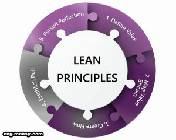Lean Principles an Innovative Approach for Achieving Sustainability in the Egyptian Construction Industry 2 From 11

Secondly, presenting and analysing four case studies benefited from applying (LPs) to deliver sustainable projects.
Thirdly, presenting and analysing results of a survey questionnaire directed to a sample of Egyptian Construction Firms (ECFs) to investigate their perception and application of (LPs) towards achieving sustainability objectives.
Fourthly, developing a conceptual framework to promote the use of (LPs) as an innovative tool for achieving
Sustainability in (ECI).
Finally, summarising research conclusions and recommendations useful to governmental authorities and construction professionals.
Introduction
In terms of its activities and outputs, the (CI) represents an integral part of the social development and economic growth of both developed and developing countries (Field and Ofori, 1988; Mthalane et al., 2007).
Socially, it aims to fulfill community needs through providing users with facilities for housing, education, culture, medication, business, leisure and entertainment.
In addition, it constructs infrastructure projects comprising roads, water and electricity stations as well as telecommunication networks to enable these projects to perform their intended functions effectively (Friends of the Earth, 1995).
Economically, Lowe (2003) stated that the value added of construction to the country’s Gross Domestic Product (GDP) is in the range of 7% to l0% for highly developed economies and around 3% to 6% for underdeveloped economies.
The construction outputs can be classified as a major component of investment and part of fixed capital; both are essential factors for a continuous economic growth.
Furthermore, governments frequently use the (CI) as a driver to manage the local/ national economy through’ increasing public expenditure to overcome the impact of recession and decrease the ratio of unemployment (Ball and Wood, 1995).
On the other hand, the (CI) is criticised for having negative impacts on the environment.
It is a very large consumer of non-renewable resources, a substantial source of waste and pollution to air and water.



